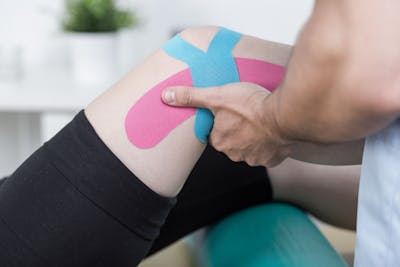
The Kinesio Taping® (KT) Method is the rehabilitative application of Kinesio® Tape to facilitate the body’s natural healing process while providing support and stability to muscles and joints without restricting the body’s range of motion as well as providing extended soft tissue manipulation to prolong the benefits of manual therapy administered within the clinical setting.
Four Major Functions of Kinesio Taping®:
- Supporting the muscle: Proper taping improves the muscle’s ability to contract even when it’s weakened, reduces a feeling of pain and fatigue, and protects the muscle from cramping, over-extension and over-contraction.
- Removing congestion to the flow of body fluids: Kinesiology Tape improves blood and lymphatic circulation and reduces inflammation and excess chemical buildup in the tissue.
- Activating the endogenous analgesic system: “Endogenous” refers to something that is self-originating and calling something “analgesic” means that it can relieve pain in a conscious person. So, this requirement means that the tape must facilitate the body’s own healing mechanisms, a central focus in Physical Therapy.
- Correcting joint problems: The goal is improving range of motion and adjusting misalignments that result from tightened muscles.
These four functions drive the technology behind the tape, which features a very thin, highly elastic porous cotton top side, that lets the skin breathe and an underside of sticky water-repellant, medical-grade acrylic adhesive, which further supports the muscles and connective tissues. Kinesio® Tape alleviates pain and facilitates lymphatic drainage by microscopically lifting the skin, which reduces swelling and inflammation. Kinesio® Tape can be applied in hundreds of ways and has the ability to re-educate the neuromuscular system, reduce pain and inflammation, prevent injury, and promote good circulation and healing.
How Is Kinesio Tape Applied?
- For muscles that are injured or overused, needing relief and healing from pain and tightness, the tape is applied with no tension, starting from the tendons that hold the muscle to the bone and extending toward the origin of the muscle.
- For chronically injured or weakened muscles, needing support and full range of motion, the tape is applied with light tension, starting from the origin of the muscle, and extending toward the tendons that hold the muscle to the bone.
After application, the Therapists rubs the tape to activate the heat sensitive glue. Approximately 30 to 60 minutes is required for the glue to become fully activated before the patient can become physically active or shower. If activity occurs prior to this time, the tape may come off. Small amounts of body hair will not interfere with the effectiveness or adhesion of the tape. However, areas with significant amounts of hair should be clipped or shaved for best results and less pain when the tape is removed.
How Do I Maintain The Kinesio® Tape Once It Is Applied?
During the first few days, if an edge of the tape has begun to lift, it can be trimmed. Rounding the edges may help prevent the edges from lifting prematurely. To dry tape after exercising, swimming, or showering, pat gently with a towel. Do not use a hair dryer, because the adhesive is heat-activated and may become difficult to remove.
Can I Apply Kinesio® Tape Myself?
It is important to apply the Kinesio strip with the correct degree of tension. If too much tension is applied, the effects are diminished. It is better not to have enough tension than too much. This is why it is important to have the Kinesio Tape applied by an experienced Therapist, and only after a proper evaluation of your condition has been performed by qualified health professionals.
How Does Kinesio® Taping Differ From Traditional Athletic Taping?
Traditionally, athletes or others with muscle injuries would tape a muscle or joint to restrict motion and prevent further injury. Kinesiology taping takes the opposite approach, using the tape to open up the muscle and allow full movement.
How Do I Take The Tape Off?
Removing tape is best done with the guidance of your Therapist to reduce the risk of re-injury or causing new injuries (as a result of incorrect removal). It is generally much easier to do when the patient has bathed, or the tape is moist. The practitioner will remove the tape from the top down, in the direction of the body hair to limit any discomfort and skin irritation.
Do not wear Kinesio tape for greater than three days. If tape needs to be removed at home, this is best done in the shower while wetting the adhesive.


